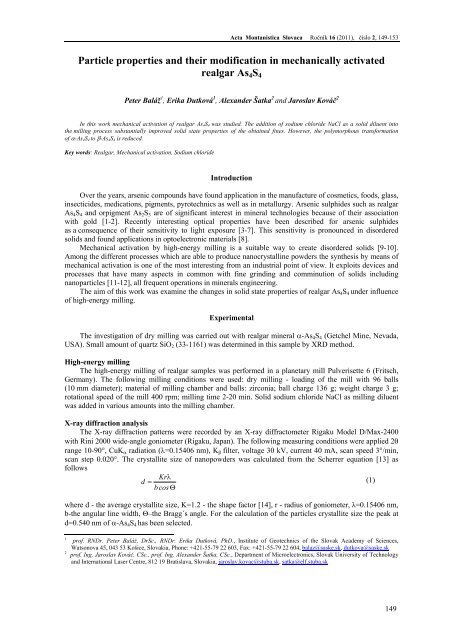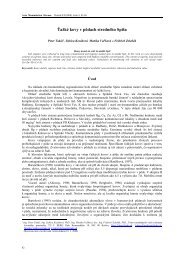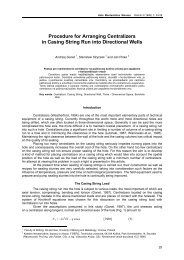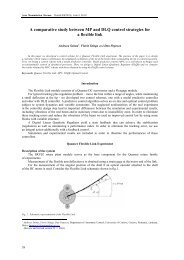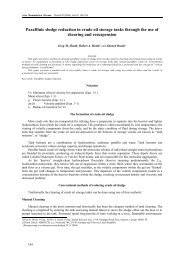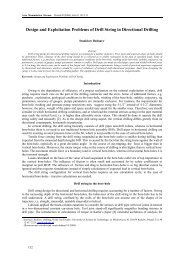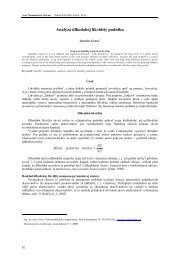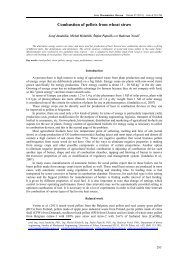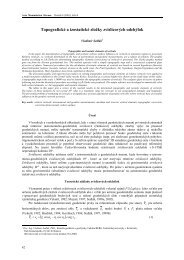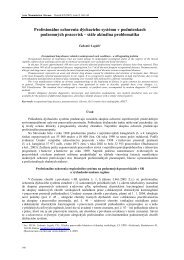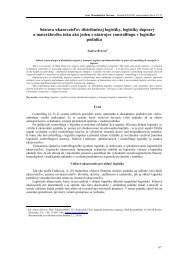Particle properties and their modification in mechanically activated ...
Particle properties and their modification in mechanically activated ...
Particle properties and their modification in mechanically activated ...
You also want an ePaper? Increase the reach of your titles
YUMPU automatically turns print PDFs into web optimized ePapers that Google loves.
Acta Montanistica Slovaca Roník 16 (2011), íslo 2, 149-153<br />
<strong>Particle</strong> <strong>properties</strong> <strong>and</strong> <strong>their</strong> <strong>modification</strong> <strong>in</strong> <strong>mechanically</strong> <strong>activated</strong><br />
realgar As4S4<br />
Peter Balá 1 , Erika Dutková 1 , Alex<strong>and</strong>er atka 2 <strong>and</strong> Jaroslav Ková 2<br />
In this work mechanical activation of realgar As4S4 was studied. The addition of sodium chloride NaCl as a solid diluent <strong>in</strong>to<br />
the mill<strong>in</strong>g process substantially improved solid state <strong>properties</strong> of the obta<strong>in</strong>ed f<strong>in</strong>es. However, the polymorphous transformation<br />
of -As4S4 to -As4S4 is reduced.<br />
Key words: Realgar, Mechanical activation, Sodium chloride<br />
Introduction<br />
Over the years, arsenic compounds have found application <strong>in</strong> the manufacture of cosmetics, foods, glass,<br />
<strong>in</strong>secticides, medications, pigments, pyrotechnics as well as <strong>in</strong> metallurgy. Arsenic sulphides such as realgar<br />
As4S4 <strong>and</strong> orpigment As2S3 are of significant <strong>in</strong>terest <strong>in</strong> m<strong>in</strong>eral technologies because of <strong>their</strong> association<br />
with gold [1-2]. Recently <strong>in</strong>terest<strong>in</strong>g optical <strong>properties</strong> have been described for arsenic sulphides<br />
as a consequence of <strong>their</strong> sensitivity to light exposure [3-7]. This sensitivity is pronounced <strong>in</strong> disordered<br />
solids <strong>and</strong> found applications <strong>in</strong> optoelectronic materials [8].<br />
Mechanical activation by high-energy mill<strong>in</strong>g is a suitable way to create disordered solids [9-10].<br />
Among the different processes which are able to produce nanocrystall<strong>in</strong>e powders the synthesis by means of<br />
mechanical activation is one of the most <strong>in</strong>terest<strong>in</strong>g from an <strong>in</strong>dustrial po<strong>in</strong>t of view. It exploits devices <strong>and</strong><br />
processes that have many aspects <strong>in</strong> common with f<strong>in</strong>e gr<strong>in</strong>d<strong>in</strong>g <strong>and</strong> comm<strong>in</strong>ution of solids <strong>in</strong>clud<strong>in</strong>g<br />
nanoparticles [11-12], all frequent operations <strong>in</strong> m<strong>in</strong>erals eng<strong>in</strong>eer<strong>in</strong>g.<br />
The aim of this work was exam<strong>in</strong>e the changes <strong>in</strong> solid state <strong>properties</strong> of realgar As4S4 under <strong>in</strong>fluence<br />
of high-energy mill<strong>in</strong>g.<br />
Experimental<br />
The <strong>in</strong>vestigation of dry mill<strong>in</strong>g was carried out with realgar m<strong>in</strong>eral -As4S4 (Getchel M<strong>in</strong>e, Nevada,<br />
USA). Small amount of quartz SiO2 (33-1161) was determ<strong>in</strong>ed <strong>in</strong> this sample by XRD method.<br />
High-energy mill<strong>in</strong>g<br />
The high-energy mill<strong>in</strong>g of realgar samples was performed <strong>in</strong> a planetary mill Pulverisette 6 (Fritsch,<br />
Germany). The follow<strong>in</strong>g mill<strong>in</strong>g conditions were used: dry mill<strong>in</strong>g - load<strong>in</strong>g of the mill with 96 balls<br />
(10 mm diameter); material of mill<strong>in</strong>g chamber <strong>and</strong> balls: zirconia; ball charge 136 g; weight charge 3 g;<br />
rotational speed of the mill 400 rpm; mill<strong>in</strong>g time 2-20 m<strong>in</strong>. Solid sodium chloride NaCl as mill<strong>in</strong>g diluent<br />
was added <strong>in</strong> various amounts <strong>in</strong>to the mill<strong>in</strong>g chamber.<br />
X-ray diffraction analysis<br />
The X-ray diffraction patterns were recorded by an X-ray diffractometer Rigaku Model D/Max-2400<br />
with R<strong>in</strong>i 2000 wide-angle goniometer (Rigaku, Japan). The follow<strong>in</strong>g measur<strong>in</strong>g conditions were applied 2<br />
range 10-90°, CuK radiation (=0.15406 nm), K filter, voltage 30 kV, current 40 mA, scan speed 3°/m<strong>in</strong>,<br />
scan step 0.020°. The crystallite size of nanopowders was calculated from the Scherrer equation [13] as<br />
follows<br />
Kr<br />
d (1)<br />
b cos <br />
where d - the average crystallite size, K=1.2 - the shape factor [14], r - radius of goniometer, =0.15406 nm,<br />
b-the angular l<strong>in</strong>e width, the Bragg´s angle. For the calculation of the particles crystallite size the peak at<br />
d=0.540 nm of -As4S4 has been selected.<br />
1 prof. RNDr. Peter Balá , DrSc., RNDr. Erika Dutková, PhD., Institute of Geotechnics of the Slovak Academy of Sciences,<br />
Watsonova 45, 043 53 Ko ice, Slovakia, Phone: +421-55-79 22 603, Fax: +421-55-79 22 604, balaz@saske.sk, dutkova@saske.sk<br />
2 prof. Ing. Jaroslav Ková, CSc., prof. Ing. Alex<strong>and</strong>er atka, CSc., Department of Microelectronics, Slovak University of Technology<br />
<strong>and</strong> International Laser Centre, 812 19 Bratislava, Slovakia, jaroslav.kovac@stuba.sk, satka@elf.stuba.sk<br />
149
Peter Balá , Erika Dutková, Alex<strong>and</strong>er atka <strong>and</strong> Jaroslav Ková: <strong>Particle</strong> <strong>properties</strong> <strong>and</strong> <strong>their</strong> <strong>modification</strong> <strong>in</strong> <strong>mechanically</strong><br />
<strong>activated</strong> realgar As4S4<br />
Specific surface area<br />
The specific surface area was determ<strong>in</strong>ed by the low temperature nitrogen adsorption method.<br />
Gem<strong>in</strong>i 2360 sorption apparatus (Micromeritics, USA) has been applied.<br />
<strong>Particle</strong> size distribution<br />
The particle size distribution of the realgar was measured by a laser beam scatter<strong>in</strong>g <strong>in</strong> a Helos <strong>and</strong><br />
Rodos granulometer (Sympatec GmbH, Germany). The mean particle diameter was calculated as the first<br />
moment of the volume size distribution function.<br />
SEM<br />
The morphology of the samples was analyzed us<strong>in</strong>g FE-SEM LEO 1550 scann<strong>in</strong>g microscope<br />
(Germany). The samples were not covered with any conductive material <strong>in</strong> order to avoid artifacts.<br />
150<br />
Results <strong>and</strong> discussion<br />
X-ray diffraction patterns of the realgar particles milled for 1, 4, 15 <strong>and</strong> 20 m<strong>in</strong>utes have been shown <strong>in</strong><br />
Fig. 1. The patterns show many overlapp<strong>in</strong>g peaks with tendency of the gradual amorphization as<br />
a consequence of crystal structure disorder<strong>in</strong>g. The identified peaks belong to various arsenic sulphide phases<br />
(as analyzed further). Peak Q belongs to the admixtured quartz SiO2 (33-1161). The whole process of realgar<br />
structure changes has been described <strong>in</strong> detail <strong>in</strong> [15]. The decrease of realgar nanosize particles from 60 to<br />
16 nm has been registered. However, the addition of solid sodium chloride NaCl <strong>in</strong>to the mill<strong>in</strong>g process was<br />
not applied <strong>in</strong> this paper.<br />
Fig. 1. XRD patterns of nanocrystall<strong>in</strong>e realgar As4S4 milled at different times (mill<strong>in</strong>g time <strong>in</strong> patterns), Q-quartz SiO2, 2 = 10-90°<br />
[15].<br />
Fig. 2. SEM of realgar As4S4 milled at 20 m<strong>in</strong>.
Acta Montanistica Slovaca Roník 16 (2011), íslo 2, 149-153<br />
SEM microphotographs of milled As4S4 (Fig. 2) show glassy structures, which are characteristic for<br />
these types of compounds.<br />
The dependence of new surface area, SA on mill<strong>in</strong>g of realgar <strong>in</strong> a dry mode is given <strong>in</strong> Table 1. From<br />
the data one can conclude that the highest value of SA was atta<strong>in</strong>ed at tM = 7 m<strong>in</strong>. The prolonged mill<strong>in</strong>g is<br />
characterized by a decrease <strong>and</strong> stagnation of SA values.<br />
Mill<strong>in</strong>g time<br />
[m<strong>in</strong>]<br />
Tab. 1. Specific surface are, SA of the milled realgar As4S4.<br />
SA<br />
[m 2 g -1 ]<br />
0 0.3<br />
2 0.9<br />
4 1.6<br />
7 2.0<br />
10 1.3<br />
15 1.1<br />
20 1.3<br />
There are several approaches to improve the mill<strong>in</strong>g behaviour of solids at higher energy <strong>in</strong>put where<br />
agglomeration phenomena usually play decisive role [9-10, 16]. The application of a washable solid diluent<br />
sodium chloride NaCl directly <strong>in</strong>to the mill<strong>in</strong>g process has been applied several times by mechanochemical<br />
synthesis of advanced nanocrystall<strong>in</strong>e powders [17-21]. The use of the diluent reduces the volume fraction of<br />
nanoparticles <strong>and</strong> consequently prevents nanoparticles be<strong>in</strong>g agglomerated <strong>and</strong> control the particle size<br />
distribution.<br />
Sodium chloride NaCl has been applied <strong>in</strong> our study as a solid diluent <strong>in</strong> realgar mill<strong>in</strong>g <strong>in</strong> order to<br />
modify the <strong>properties</strong> of f<strong>in</strong>es. After mill<strong>in</strong>g, water soluble NaCl was washed out with de-ionized water us<strong>in</strong>g<br />
ultrasonic bath. In Figure 3 the values of specific surface area for selected mill<strong>in</strong>g times <strong>and</strong> various<br />
NaCl/As4S4 ratio are given.<br />
Fig. 3. Specific surface area of realgar As4S4 <strong>in</strong> dependence of NaCl/As4S4 ratio (w/w).<br />
The addition of NaCl had positive <strong>in</strong>fluence on surface area of milled realgar particles which <strong>in</strong>creased<br />
several times <strong>in</strong> comparison with realgar milled without diluent. However, the effect of NaCl addition is<br />
limited by the value NaCl/As4 S4=2.0. The further <strong>in</strong>crease of NaCl amount has no effect. The dilution of<br />
milled realgar with sodium chloride over this critical value is so large that realgar particles loose contact <strong>and</strong><br />
the mill<strong>in</strong>g energy is preferentially transferred to NaCl particles. As consequence, the particle size of realgar<br />
nanoparticles is practically constant (Fig. 3).<br />
It has been shown <strong>in</strong> our previous work that the transition of the low temperature -As4S4 to the hightemperature<br />
-As4S4 as well as the formation of nanosize realgar particles <strong>in</strong> the range 16-48 nm is possible<br />
[15].<br />
However, the dilution effect of NaCl addition has detrimental <strong>in</strong>fluence on transformation of<br />
realgar (Fig. 4).<br />
151
Peter Balá , Erika Dutková, Alex<strong>and</strong>er atka <strong>and</strong> Jaroslav Ková: <strong>Particle</strong> <strong>properties</strong> <strong>and</strong> <strong>their</strong> <strong>modification</strong> <strong>in</strong> <strong>mechanically</strong><br />
<strong>activated</strong> realgar As4S4<br />
152<br />
Fig. 4. Dependence of realgar As4S4 conversion<br />
degree, on dilution by NaCl, NaCl/As4S4 (mill<strong>in</strong>g time 7 m<strong>in</strong>).<br />
The value =28 % has been obta<strong>in</strong>ed for sample milled for 7 m<strong>in</strong> which is substantially lower as the<br />
value =55 % obta<strong>in</strong>ed for the same sample but without addition of NaCl. The sodium chloride matrix phase<br />
effectively separated the milled powder thus allow<strong>in</strong>g the nanocrystall<strong>in</strong>e gra<strong>in</strong> structure that was developed<br />
dur<strong>in</strong>g mill<strong>in</strong>g. However, from the po<strong>in</strong>t of mechanochemical polymorphous transformation this effect has<br />
retard<strong>in</strong>g <strong>in</strong>fluence on realgar conversion degree as a consequence of reduc<strong>in</strong>g the diffusion<br />
phenomena, which are predispos<strong>in</strong>g for the reaction procedure.<br />
Conclusions<br />
1. Increase <strong>in</strong> specific surface area of realgar As4S4 particles when us<strong>in</strong>g sodium chloride NaCl as a solid<br />
diluent dur<strong>in</strong>g mill<strong>in</strong>g has been detected.<br />
2. Application of sodium chloride NaCl by mill<strong>in</strong>g has a detrimental effect on conversion<br />
of As4S4.<br />
References<br />
Acknowledgements: The support through the Slovak<br />
Research <strong>and</strong> Develop<strong>in</strong>g Agency (project APVV-<br />
0189-10), the Slovak Grant Agency (project VEGA<br />
2/0009/11) is gratefully acknowledged. This work<br />
was realized with<strong>in</strong> the frame of the project Center<br />
of Excellence of Advanced Materials with Nano- <strong>and</strong><br />
Submicron- Structure that is supported by the<br />
Operational Program Research <strong>and</strong> Development<br />
f<strong>in</strong>anced through European Regional Development<br />
Fund.<br />
[1] Lengke, M.F., Tempel, R.N.: Natural realgar <strong>and</strong> amorphous AsS oxidation k<strong>in</strong>etics. Geochim.<br />
Cosmochim. Acta 67, 2003, 859-871.<br />
[2] Lengke, M.F., Tempel, R.N.: Geochemical modell<strong>in</strong>g of arsenic sulfide oxidation k<strong>in</strong>etics <strong>in</strong> a m<strong>in</strong><strong>in</strong>g<br />
environment. Geochim. Cosmochim. Acta 69, 2005, 341-356.<br />
[3] Bonazzi, P., Menchetti, S., Pratesi, G.: The crystal structure of pararealgar As4S4. Amer. M<strong>in</strong>er. 80,<br />
1995, 400-403.<br />
[4] Bonazzi, P., Menchetti, S., Pratesi, G., Muniz-Mir<strong>and</strong>a, M., Sbrana, G.: Light-<strong>in</strong>duced variation <strong>in</strong><br />
realgar <strong>and</strong> -As4S4: X-ray diffraction <strong>and</strong> Raman studies. Amer. M<strong>in</strong>er. 81, 1996, 874-880.<br />
[5] Frumar, M., Vlek, M., erno ek, Z., Polák, Z., Wágner, T.: Photo<strong>in</strong>duced changes of the structure<br />
<strong>and</strong> physical <strong>properties</strong> of amorphous chalcogenides. J. Non-Cryst. Solids 213-214, 1997, 215-224.
Acta Montanistica Slovaca Roník 16 (2011), íslo 2, 149-153<br />
[6] Nmec, P., Jedelský, J., Frumar, Z., erno ek, Vlek, M.: Structure of pulsed-laser deposited arsenicrich<br />
As-S amorphous th<strong>in</strong> films, <strong>and</strong> effect of light <strong>and</strong> temperature. J. Non-Cryst. Solids 351, 2005,<br />
3497-3502.<br />
[7] Bonazzi, P., B<strong>in</strong>di, L.: A crystallographic review of arsenic sulfides: effect of chemical variations <strong>and</strong><br />
changes <strong>in</strong>duced by exposure to light. Zeitschrift für Kristallographie 223, 2008, 132-147.<br />
[8] Popescu, M.: Disordered chalcogenide optoelectronic materials: phenomena <strong>and</strong> applications. J.<br />
Optoel. Adv. Mater. 7, 2005, 2189-2210.<br />
[9] Balá , P.: Extractive Metallurgy of Activated M<strong>in</strong>erals, Elsevier, Amsterdam, 2000.<br />
[10] Balá , P.: Mechanochemistry <strong>in</strong> Nanoscience <strong>and</strong> M<strong>in</strong>erals Eng<strong>in</strong>eer<strong>in</strong>g, Spr<strong>in</strong>ger, Berl<strong>in</strong> Heidelberg,<br />
2008.<br />
[11] Wills, B.A.: M<strong>in</strong>eral Process<strong>in</strong>g Technology: an Introduction to the Practical Aspects of Ore<br />
Treatment <strong>and</strong> M<strong>in</strong>eral Recovery, Butterworth-He<strong>in</strong>emann, 2000.<br />
[12] Miani, F., Maurigh, F.: Mechanosynthesis of nanophase powders, In: Dekker Encyclopedia of<br />
Nanoscience <strong>and</strong> Nanotechnology (J.A. Schwarz, C.J. Contescu, K. Putyera, eds.), Marcel Dekker,<br />
New York, 2004, 1787-1795.<br />
[13] Scherrer, P.: Bestimmung der Grösse und der <strong>in</strong>neren Struktur von Kolloidteilchen mittels<br />
Röntgenstrahlen. Nachr. Ges. Wiss. Gött<strong>in</strong>gen 2, 1918, 98-103.<br />
[14] Borchert, H., Shevchenko, E.V., Robert, A., Makis, I., Kornowski, A., Grübel, G., Weller, H.:<br />
Determ<strong>in</strong>ation of nanocrystal sizes: A comparison of TEM, SAXS, <strong>and</strong> XRD studies of highly<br />
monodisperse CoPt3 particles. Langmuir 21, 2005, 1931-1936.<br />
[15] Balá , P., Choi, W.S., Dutková, E.: Mechanochemical <strong>modification</strong> of <strong>properties</strong> <strong>and</strong> reactivity of<br />
nanosized arsenic sulphide As4S4. J. Phys. Chem. Solids 68, 2007, 1178-1183.<br />
[16] Tkáová, K.: Mechanical Activation of M<strong>in</strong>erals, Elsevier, Amsterdam, 1989.<br />
[17] D<strong>in</strong>g, J., Tsuzuki, T., McCormick, P.G., Street, R.: Ultraf<strong>in</strong>e Co <strong>and</strong> Ni particles prepared by<br />
mechanochemical process<strong>in</strong>g. J. Phys. D: Appl. Phys., 29, 1996, 2365-2369.<br />
[18] Deng, H.M., D<strong>in</strong>g, J., Shi, Y., l<strong>in</strong>, X.Y., Wang, J.: Ultraf<strong>in</strong>e z<strong>in</strong>c oxide powders prepared by<br />
precipitation/mechanical mill<strong>in</strong>g. J. Mater. Sci. 36, 2001, 3273-3276.<br />
[19] Hos, J.P., McCormick, P.G.: Mechanochemical synthesis <strong>and</strong> characterization of nanoparticulate<br />
samarium-doped cerium oxide. Scripta Mater. 48, 2003, 85-90.<br />
[20] Yang, H., Hu, Y., Tang, A., J<strong>in</strong>, S., Q<strong>in</strong>, G.: Synthesis of t<strong>in</strong> oxide nanoparticles by mechanochemical<br />
action. J. Alloys Comp., 363, 2004, 276-279.<br />
[21] Tsuzuki, T., McCormick, P.G.: Mechanochemical synthesis of nanoparticles. J. Mater. Sci., 39, 2004,<br />
5143-5146.<br />
153


